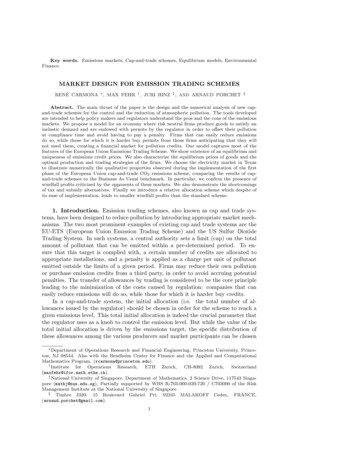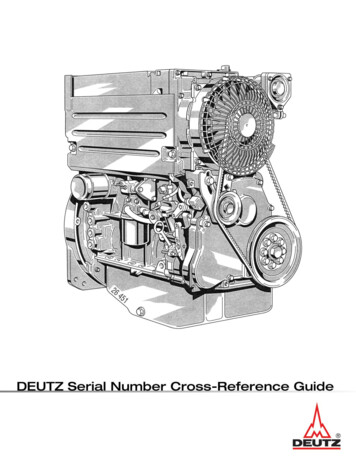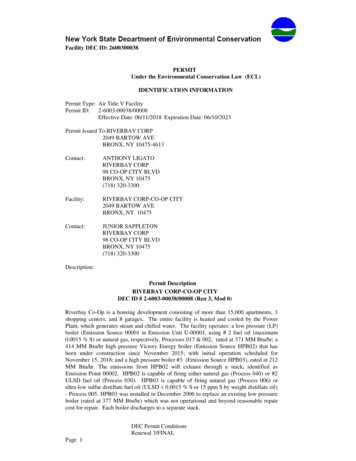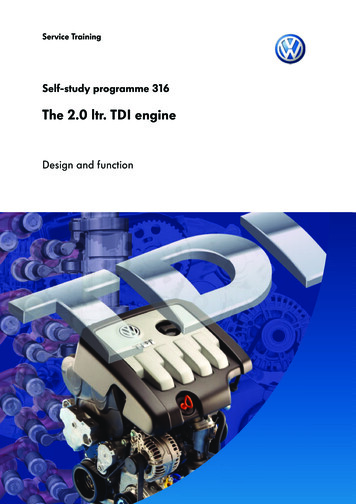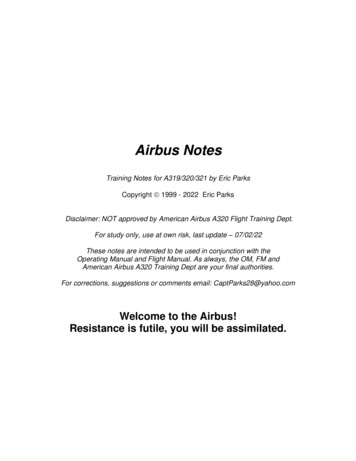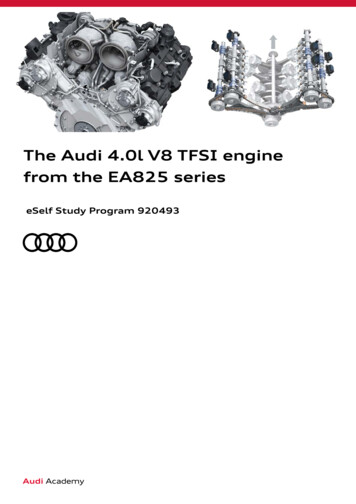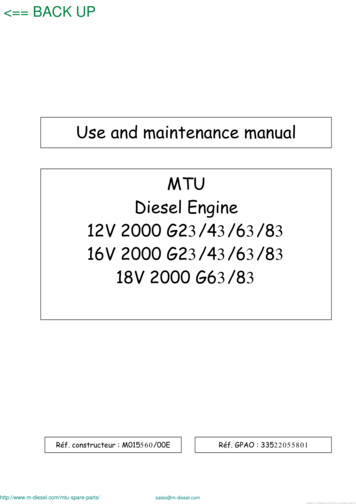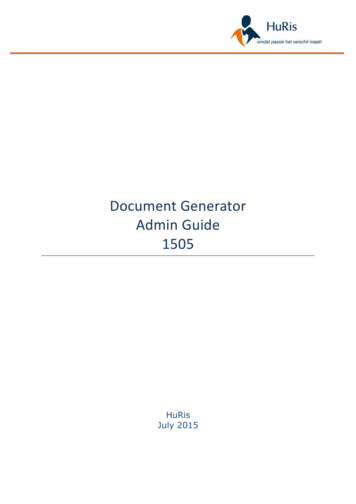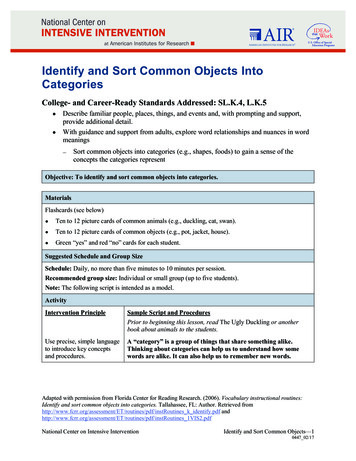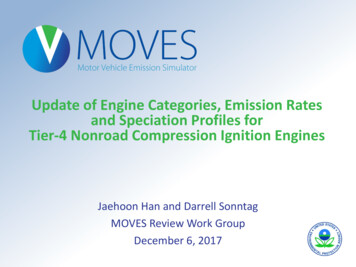
Transcription
Update of Engine Categories, Emission Ratesand Speciation Profiles forTier-4 Nonroad Compression Ignition EnginesJaehoon Han and Darrell SonntagMOVES Review Work GroupDecember 6, 2017
Agenda Emission StandardsCompliance TechnologyScope of Modeling UpdatesData and ApproachesSummaryQ&AThis presentation includes preliminary results fromanalysis in progress. The actual implementation infuture MOVES versions is subject to change.2
EPA Nonroad Compression IgnitionExhaust Emission Standards*kW (HP)20012002200320042005200620072008 8 (11)7.5-----0.807.5-----0.40 8 (11) 19 (25)7.5-----0.807.5-----0.407.5-----0.60 19 (25) 37 (50) 37 (50) 56 (75) Opt 17.5-----0.40Opt 27.5-----0.40 56 (75) 75 (100) 75 (100) 130 (175)6.6-----0.30 130 (175) 225 (300)6.6-----0.20 225 (300) 450 (600) 450 (600) 560 (750) 560 (750)6.4-----0.202009201020112012201320142015TIER Color CodeTier 1Tier 2Tier ----0.30Tier 4 TransitionalTier 4 FinalRates 90.026.4-----0.203.50.190.100.400.190.02NMHC 0.20* EPA NRCI exhaust emission standards at https://nepis.epa.gov/Exe/ZyPDF.cgi?Dockey P100OA05.pdf3.50.190.043
Tier-4 Compliance Technology After-treatment systems– Selective Catalytic Reduction (SCR) for NOx– Diesel Particulate Filter (DPF) for PM– Diesel Oxidation Catalyst (DOC) for HC/CO/PM, In-cylinder air handling technology– Exhaust Gas Recirculation (EGR)– Turbo-charging, In-cylinder fuel injection system– Injection pressure, rate, timing, Emission rates vary depending on technology4
MOVES2014a NRCI Modeling “Engine technology categories” for NRCI equipment– Defined to assign population fractions & emission factors– Classification based on EPA emission standards– Not differentiated by control technology Population fraction values for Tier-4 model years– Estimates based on Tier-4 Transitional (Interim) & FinalStandards phase-in schedule Emission factor values for Tier-4 model years– Estimates based on standards with compliance marginapplied5
Scope of Tier-4 Updates Engine technology categories– New Tier-4 definition considering after-treatment types Population fractions*– Tier-4 data from EPA engine certification database (VERIFY)– Consideration of Tier-4 flexibility program (TPEM) Emission factors– Tier-4 rates from engine certification database (VERIFY) Speciation profiles– Differentiation based on after-treatment types– A topic discussed in 2017 June Workgroup meeting*Note: Population growth updates are handled in other related projects.6
Recommended Engine TechCategories New Tier-4 Definition– Now considering after-treatment configurationsI: Interim (Transitional)ANo DPFNo SCRBNo DPFWith SCRCWith DPFNo SCRDWith DPFWith SCRF: Final7
Engine Certification Data NRCI compliance data extracted from VERIFY– Model yearsfrom 2011* thru 2017– Includes info about: Engine family Power category Applicable certification tier After-treatment devicetypes Emission rates: NOx, PM,NMHC, CO Projected sales volume(CBI)*Partial data for MY 20118
Certified Engine Population Fractions The volume-averaged fractions of the enginesin each engine tech category are calculated– Per power category– Per model year group “Stationary engines” in certification data set– Exemption clause in Tier-4 rules*– Certified as “Tier 2” or “Tier 3” instead– Excluded from our analysis since MOVES has “mobile engine” population pment-compression9
Certified Engine Population FractionsHP 25HP 25 to 5010
Certified Engine Population FractionsHP 50 to 75HP 75 to 10011
Certified Engine Population FractionsHP 100 to 175HP 175 to 30012
Certified Engine Population FractionsHP 300 to 600HP 600 to 75013
Certified Engine Population FractionsHP 750 - non generatorHP 750 to 1200 - generator14
Certified Engine Population FractionsHP 1200 - generator15
TPEM Exemption Transition Program for Equipment Manufacturers*(a.k.a. “flexibility program”)– Temporary exemption that allows equipmentmanufacturers to delay installing Tier-4 compliant enginesin their products for up to 7 yearsTPEM Color CodeTier 4 Regular TPEM availableTier 4 Delayed TPEM available– Participation is voluntary* 16
Certified vs. TPEM Engine Volumes The volume ratio of Tier-4 certified engines to the TPEMengines needs to be accounted for in the total populationfraction calculation Analysis is in progress using limited data available based onyearly reports from manufacturers to EPA (separate DB fromVERIFY)17
Recommended Emission FactorsHP 11error barMOVES2014alevelRecord CountNOxNMHCPM18
Recommended Emission FactorsHP 11 to 25Record CountNOxNMHCPMerror barMOVES2014alevel19
Recommended Emission FactorsHP 25 to 50Record CountNOxNMHCPMerror barMOVES2014alevel20
Recommended Emission FactorsHP 50 to 75Record CountNOxNMHCPMerror barMOVES2014alevel21
Recommended Emission FactorsHP 75 to 100Record CountNOxNMHCPMerror barMOVES2014alevel22
Recommended Emission FactorsHP 100 to 175Record CountNOxNMHCPMerror barMOVES2014alevel23
Recommended Emission FactorsHP 175 to 300Record CountNOxNMHCPMerror barMOVES2014alevel24
Recommended Emission FactorsHP 300 to 600Record CountNOxNMHCPMerror barMOVES2014alevel25
Recommended Emission FactorsHP 600 to 750Record CountNOxNMHCPMerror barMOVES2014alevel26
Recommended Emission FactorsHP 750 – non generatorRecord CountNOxNMHCPMerror barMOVES2014alevel27
Recommended Emission FactorsHP 750 to 1200 - generatorRecord CountNOxNMHCPMerror barMOVES2014alevel28
Recommended Emission FactorsHP 1200 - generatorRecord CountNOxNMHCPMerror barMOVES2014alevel29
RecommendedSpeciation/Toxic Update Distinguish Tier-4 engines equipped with differentafter-treatment technologyEngine Tech CategoryProfilefor TOGspeciationToxic Fraction ofVOCPAHemissions factorsMetalemission factors*Tier 2 nonroaddiesel engine Same way as Tiers 2& 3 using nonroad CItest program dataSame way as pre-Tier 4using onroad data(as faction of PM2.5)ANo DPFNo SCRBNo DPFWith SCRCWithDPFNO SCRACES Phase 1onroad data DWithDPFWith SCRACES Phase 2onroad data * For Manganese and Nickel; Pollutant specific approaches for other metals30
Summary We are proposing updating the Tier 4 nonroaddiesel engine classification, population split,emission rates based primarily on EPAcertification data sets. The effect of different after-treatmentconfigurations will be accounted for in orderto enhance modeling detail. It will also allow different speciation by aftertreatment configurations.31
QUESTIONS?32
Certified Engine Population Fractions The volume-averaged fractions of the engines in each engine tech category are calculated -Per power category -Per model year group Stationary engines in certification data set -Exemption clause in Tier-4 rules* -Certified as Tier 2 or Tier 3 instead -Excluded from our analysis
